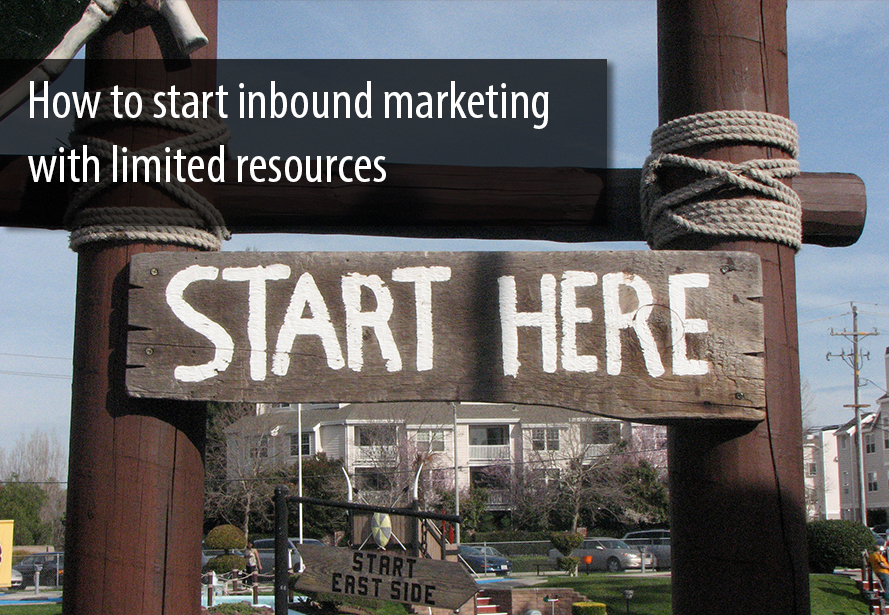5 Tactics to Jump-start Your Inbound Marketing

Implementing a holistic inbound marketing strategy is challenging. Without adequate resources to throw at the effort, it’s even more challenging. Still, many small businesses are looking at how they can replace many of their outbound marketing tactics with more inbound ones. They understand that striking the right balance between inbound and outbound marketing can lead to increased ROI and free-up budget.
In a perfect world, your boss would let you hire a team of inbound rockstars and implement the latest greatest marketing automation system. When this isn’t possible, the next best thing is starting small, optimizing a few inbound tactics, and scaling up from there. But with so many components to a successful inbound strategy, where do you begin?
Here are a few suggestions on where to start if you’re ready to go inbound but unable to go all-out:
1. Blogging
Though it can be labor-intensive, blogging helps your business work toward multiple marketing goals all at once. Writing up regular posts that benefit your prospects and customers will:
- Support sales by providing information that speaks to prospect/customer FAQs, challenges, and goals
- Boost SEO and help your business get found by featuring keyword-rich content in line with what prospects are searching for
- Address questions about your product and industry, creating a better user experience and instant credibility
2. Buyer Persona Research
If you can only pull off one inbound activity, buyer persona research is the first and best step because it will help you target key audiences better whether you’re executing more inbound or outbound tactics. For those of you unfamiliar with buyer personas, they are: profiles you create that represent your ideal customers.
To create buyer persona profiles, you collect data on existing customers, research the marketplace, and gather first-hand insights from your team and other departments at your company. (Pro-tip: salespeople are a great resource when learning more about ideal customers since they have daily first-hand experience with prospects and customers.)
For example, a software company selling to B2B sales departments may have two personas:
1) Entry-level salespeople who use their software, and
2) Sales directors and VPs who make the buying decisions
The software company would then use profiles for each of these personas to make sure the marketing they do for each is relevant. It’s a great way to make sure your marketing team is in-tune with each type of customer.
3. Source Reporting
A core tenet to any smart marketing strategy is understanding where your prospects are and how they find you. With web marketing, you have to understand where your site traffic is coming from so you know what’s working and can adapt accordingly. Even more importantly, you need to track and analyze where customers who ultimately buy discovered your site. Tracking sources is a great first step to understanding prospect behavior on the web. Over time you'll see how helpful this kind of data-driven optimization can be.
4. TOFU Offer
Before you can worry about nurturing leads and closing deals, you have to generate some attention around your brand and product offering. While social channels and traditional advertising methods can work great for brand awareness, you need to capture information from those visitors in order to move them closer to a sale.
A very classic “inbound” way to do this would be to create some type of content offer prospects need to fill out a form to access. This offer could be anything that adds real value to the prospect’s life or job and isn’t too sales-focused. Some great examples include thought leadership ebooks, white papers, useful templates and how-to guides.
Creating this type of premium content offer can be daunting, but once you have one in place, it’s likely to generate leads continuously over a long period of time - sometimes even years. Here are some content creation tips for creating more content with fewer resources.
5. Email Marketing Campaigns
If you’re already successfully generating new leads, the next step is to nurture them. Unless your company has an extremely short sales cycle, prospects need some warming up before they’re ready to buy. Marketing with content is a great way to do this.
In an ideal world, you’ve captured the prospect’s email address and can set up a series of emails to continue providing valuable content. If you don’t have a blog to link to as your content offer (or any premium content), you can create a quick video or offer a few quick tips your target customer would appreciate. If you want to be more aggressive, you can provide a coupon or limited-time offer to accelerate the sale.
What inbound tactics have you tried that are working great? What hasn’t worked as well?
Image by Todd Dailey via Flickr, licensed under CC BY-SA

